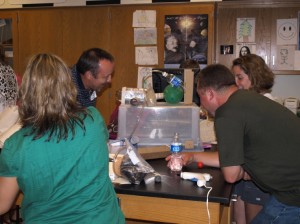Informal professional development
By Mary Bigelow
Posted on 2015-09-10
 I teach in a private school that does not offer much in terms of professional development (PD), especially for science teachers. My colleagues and I would like to visit some science museums and centers. Would that count as PD? Do you have any other suggestions for us? —M., Maryland
I teach in a private school that does not offer much in terms of professional development (PD), especially for science teachers. My colleagues and I would like to visit some science museums and centers. Would that count as PD? Do you have any other suggestions for us? —M., Maryland
To a science teacher, an ideal day away from school might include a stroll through a zoo or botanical garden, an afternoon in a cool planetarium or aquarium, a visit to a science center or natural history museum, or a hike through the woods or on a beach with a camera, a pair of binoculars, and a guidebook. On these personal field trips, we don’t need to worry about permission slips and bus counts – we can follow our interests and learn on our own terms.
It’s enjoyable to visit one of these places with another science teacher. The level of conversation is different than when you visit these places alone, with students, or with your families. A day exploring one of these venues and discussing science topics is a great way to increase content knowledge and examine different ways of learning.
For example, one day at the American Museum of Natural History in New York, my colleague and I spent a lot of time with the exhibits related to plate tectonics. We learned new content information, and the displays gave us some ideas for sharing this information with our students. We took lots of notes and made lots of sketches. (Our spouses, who are not science teachers, eventually wandered off to other exhibits!)
My school district allowed my colleague and me to count the time we spent in the museum as PD hours. We submitted a report describing where we went, what we did, what we learned, and how that learning will apply to the classroom. You could ask your school administrator if such a procedure would be acceptable in your situation.
With all that we can learn both onsite and online (through websites, e-mail lists, and social media), perhaps this informal, individualized PD should become a viable part of our ongoing professional education. Unlike more formal, school-wide PD events, we set the goals and personalize the experience to our own needs. This process keeps us informed and up-to-date, building on our previous knowledge and inspiring us to continue to learn new things. (I’m sure that my childhood visits to the Franklin Institute in Philadelphia had a profound influence on my own interest in science.)
NSTA’s position statement on informal science education recognizes the contributions of informal science institutions and organizations in providing opportunities for lifelong learning—and not just for students but for teachers, too.
You can also visit science museums and centers through the eyes of your students. What strategies do the informal educators use to attract our attention and hold our interest in the exhibits? In The Science Teacher, “Learning Science Beyond the Classroom” describes some of these techniques. Could any of these apply to the classroom?
As the price of travel increases, don’t forget to visit places close to home. To find a new place to visit, check out the website of the Association of Zoos and Aquariums or the American Alliance of Museums. If you’re a member of an organization, check for reciprocal admissions. Many of these organizations offer lectures, field trips, hands-on workshops, graduate study, meet-a-scientist, and other special events that could become part of an individualized or informal PD plan.
Many of these informal science venues have excellent websites, too. I can spend hours on the website of the Exploratorium in San Francisco with its comprehensive collection of lessons and demonstrations for the classroom. These institutions may also have virtual tours, too. The National Park Service website has armchair views of the parks – not quite the same as being there, but still a good experience.
Adding informal, teacher-selected opportunities to a school’s PD plan is a win-win option. Teachers (or groups of teachers) can design opportunities based on their individual subject area needs and the school can spend its ever-decreasing PD funds on school-wide topics.
More PD suggestions:
Disclaimer: The views expressed in this blog post are those of the author(s) and do not necessarily reflect the official position of the National Science Teaching Association (NSTA).


